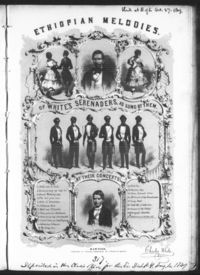Annotation:Nancy Till: Difference between revisions
Alan Snyder (talk | contribs) (Fix HTML) |
m (Text replacement - "garamond, serif" to "sans-serif") |
||
| Line 1: | Line 1: | ||
=='''Back to [[{{BASEPAGENAME}}]]'''== | =='''Back to [[{{BASEPAGENAME}}]]'''== | ||
---- | ---- | ||
<p><font face=" | <p><font face="sans-serif" size="4"> | ||
'''NANCY TILL.''' AKA and see "[[Cane Break (2) (The)]]," "[[Come Love Come]]," "[[Down in de Canebreak]]," "[[Nancy Dill]]." American, Air and Two-step (4/4 time). G Major. Standard tuning (fiddle). AA'BB'. A minstrel-era song written anonymously and published in 1851. It was first performed by White's Serenaders, a popular blackface minstrel troupe, and "Nancy Till" was their most popular song. The lyric begins: | '''NANCY TILL.''' AKA and see "[[Cane Break (2) (The)]]," "[[Come Love Come]]," "[[Down in de Canebreak]]," "[[Nancy Dill]]." American, Air and Two-step (4/4 time). G Major. Standard tuning (fiddle). AA'BB'. A minstrel-era song written anonymously and published in 1851. It was first performed by White's Serenaders, a popular blackface minstrel troupe, and "Nancy Till" was their most popular song. The lyric begins: | ||
</font></p> | </font></p> | ||
[[File:white's.jpg|200px|thumb|right|White's Serenaders]] | [[File:white's.jpg|200px|thumb|right|White's Serenaders]] | ||
<blockquote><font face=" | <blockquote><font face="sans-serif" size="4"> | ||
CHO:<br> | CHO:<br> | ||
''Oh, come love, come, de boat lies low,'' <br> | ''Oh, come love, come, de boat lies low,'' <br> | ||
| Line 22: | Line 22: | ||
''An' dis shall be de song.''<br> | ''An' dis shall be de song.''<br> | ||
</font></blockquote> | </font></blockquote> | ||
<p><font face=" | <p><font face="sans-serif" size="4"> | ||
The tune appears in England in Peter Kennedy's '''Fiddler's Tune-Book''' (1951) as set as a schottishce, "Nancy Dill" with the alternate title "[[Cane Break (2) (The)]]." | The tune appears in England in Peter Kennedy's '''Fiddler's Tune-Book''' (1951) as set as a schottishce, "Nancy Dill" with the alternate title "[[Cane Break (2) (The)]]." | ||
<br> | <br> | ||
</font></p> | </font></p> | ||
<p><font face=" | <p><font face="sans-serif" size="4"> | ||
''Source for notated version'': | ''Source for notated version'': | ||
<br> | <br> | ||
<br> | <br> | ||
</font></p> | </font></p> | ||
<p><font face=" | <p><font face="sans-serif" size="4"> | ||
''Printed sources'': '''Christy's Banjo Book''', 1859. Kerr ('''Merry Melodies, vol. 2'''), c. 1880's; No. 408, p. 46. Lair ('''100 WLS Barn Dance Favorites'''), 1935; p. 74. | ''Printed sources'': '''Christy's Banjo Book''', 1859. Kerr ('''Merry Melodies, vol. 2'''), c. 1880's; No. 408, p. 46. Lair ('''100 WLS Barn Dance Favorites'''), 1935; p. 74. | ||
<br> | <br> | ||
<br> | <br> | ||
</font></p> | </font></p> | ||
<p><font face=" | <p><font face="sans-serif" size="4"> | ||
''Recorded sources'': | ''Recorded sources'': | ||
<font color=teal> | <font color=teal> | ||
Revision as of 14:28, 6 May 2019
Back to Nancy Till
NANCY TILL. AKA and see "Cane Break (2) (The)," "Come Love Come," "Down in de Canebreak," "Nancy Dill." American, Air and Two-step (4/4 time). G Major. Standard tuning (fiddle). AA'BB'. A minstrel-era song written anonymously and published in 1851. It was first performed by White's Serenaders, a popular blackface minstrel troupe, and "Nancy Till" was their most popular song. The lyric begins:

CHO:
Oh, come love, come, de boat lies low,
She lies high and dry on de Ohio,
Come love, come, won't you go 'long wid me,
I'll take you down to Tennessee.
Down by de cane brake,
Close by de mill,
Dere I met a yaller gal,
And her name was Nancy Till;
She know'd dat I loved her,
She know'd it berry long,
I'm going to serenade her,
An' dis shall be de song.
The tune appears in England in Peter Kennedy's Fiddler's Tune-Book (1951) as set as a schottishce, "Nancy Dill" with the alternate title "Cane Break (2) (The)."
Source for notated version:
Printed sources: Christy's Banjo Book, 1859. Kerr (Merry Melodies, vol. 2), c. 1880's; No. 408, p. 46. Lair (100 WLS Barn Dance Favorites), 1935; p. 74.
Recorded sources: Victor 21430 (78 RPM), Frank Crumit (1928).
